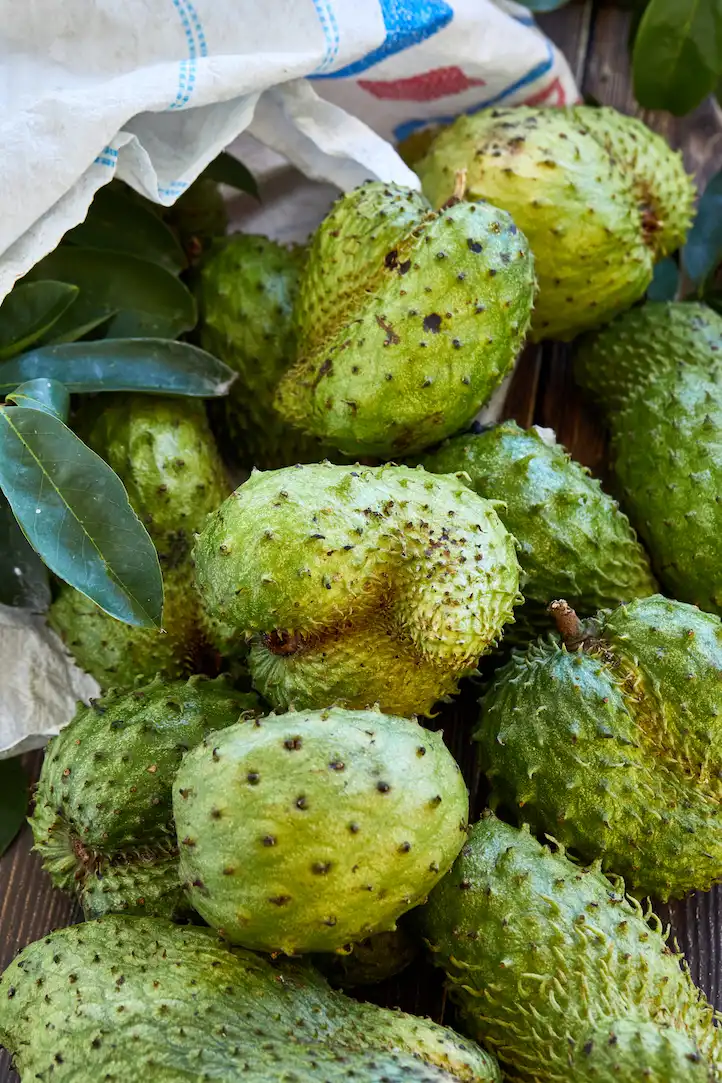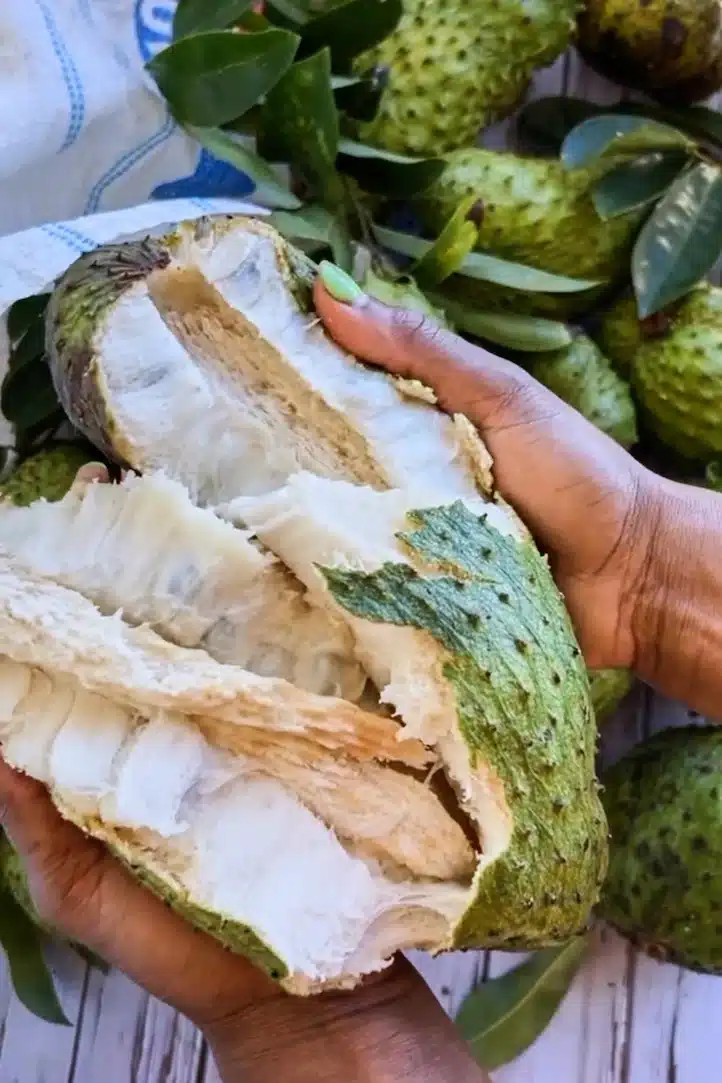
Soursop, or Guanabana, is a popular fruit in Jamaica. Graviola and Brazilian Paw Paw are names given to the soursop fruit in other parts of the world. The scientific name for soursop is Annona Muricata.
The soursop tree is widespread throughout the Caribbean, Central and South America, and Southeast Asia. Soursop trees grow best in warm, humid climates with ample rainfall, so they flourish in Jamaica.
The soursop fruit tree is evergreen and can grow up to 30 feet tall.
The soursop (guanabana) fruit varies in shape. Some soursops are oval or heart-shaped, while others have irregular shapes. The soursop varies in size, with fruits as small as 4 inches and as large as 12 inches.
The skin of the soursop fruit is green and covered with spines, and as the fruit matures, the skin changes from dark green to lighter green. The spines spread further apart and become softer.
Soursop is generally picked from the tree when it’s mature but before it is ripe. The fruit may fall to the ground and squash if left to ripe on the tree. A soursop fruit will take three to five days to ripen after being picked. Ripe soursops are soft and have a noticeable sweet, fruity scent. The spines will also easily break off when the fruit is ripe.
Is soursop related to jackfruit or cactus?
Although Soursop, Jackfruit, and Cactus all have green, prickly skin, they are not related fruits. Soursop belongs to the Annonaceae family, which includes other fruits like sugar apples. Jackfruit belongs to the Moraceae family, while the cactus belongs to the Cactaceae family. They all have distinct differences in their appearances, tastes, and uses.
Is the soursop (guanabana) fruit edible?
Soursop is an edible fruit when ripe and can be consumed raw. Some say soursop tastes like a combination of pineapple and banana.
Inside most of these segments of flesh are black, oval seeds that are smooth and hard. The segments surround the core, or heart, of the fruit, which is also edible.
The flesh, or pulp, of the soursop, comprises easily separated segments. Inside most of these pulp segments are black, oval seeds that are smooth and hard. These pulp segments surround the soursop’s core or heart, which is also edible. Usually, only the fruit’s flesh and core are eaten, while the skin and seeds are discarded.
Some Jamaicans break open soursop fruit by hand to get to the edible flesh. Others may peel off the skin first, either by hand or sometimes with a knife. Before eating the fruit, some prefer to separate the pulp into pieces and remove the seeds, while others don’t.

How is the soursop fruit used?
In addition to soursop being eaten as a tasty fruit, it is also used to make soursop juice in Jamaica. Typically, making the juice involves adding water to the flesh (or pulp) in a bowl—then squeezing or mashing the pulp with the hands to extract the soursop juice. After which, you would strain to separate the juice from the pulps. Soursop juice is either sweetened with milk or with lime and sugar.
In Jamaica, it’s typical for children to have soursop leaves as tea. The soursop tea has a pleasant taste so it is very easy to drink. The soursop leaf tea is often mixed with red root and dry banana leaf to make a tonic. This tonic is very nutritious and would often be given to malnourished children to improve their health.
What is the best way to use soursop?
Though the most common uses of soursop are to make juice or ice cream, this will not preserve all its nutritional content. The best way to use soursop is to eat it fresh from the tree. Soursop fruit has many health benefits, so when it is consumed raw, you obtain all its nutrients.

Benefits of the soursop (guanabana) fruit and plant
The soursop fruit is rich in vitamins and minerals such as vitamins C and B6, potassium, magnesium, and fibre. A whole soursop fruit provides about one-third to one-half of the daily recommended amount of potassium. The high potassium content in soursop can help reduce high blood pressure by reducing the sodium in the body.
Further, soursop also contains natural compounds, which studies have shown to have anti-inflammatory properties.
Soursop leaf tea is believe to relieve pain and helps to boost the immune system. Some studies have suggested that soursop leaves may contain potential cancer-fighting properties.
Soursop (Guanabana) plant is versatile, and its fruit offers many health benefits. Consuming raw soursop is a valuable addition to any healthy diet.
Disclaimer: The author makes no guarantees as to the curative effect of any herbs, fruits or plants mention on this website, and no visitor should attempt to use any of the information herein provided as treatment for any illness, weakness, or disease without first consulting a physician or health care provider. Pregnant women should always consult first with a health care professional before taking any treatment.
Related Post
Let’s stay connected! Find me on:
Also subscribe to my newsletter for updates on all new post!

 1 year ago
97
1 year ago
97
 English (US) ·
English (US) ·